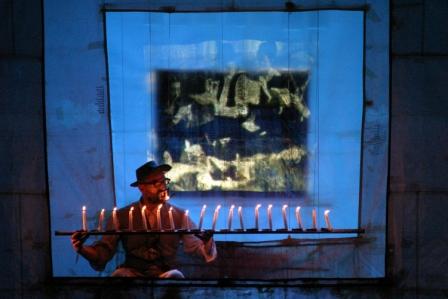White Cabin: a remote control to the unconscious

I’m at a loss to describe White Cabin, which is part of this year’s PuSh Festival.
The best I can do is to say if Slava Polunin (the creator of the best clown show ever, Snow Show) and Romeo Castellucci (the creator of Hey Girl, which was at PuSh a couple of years ago) were forced to work together this might be what they would come up with.
During the talkback after the show, Maxim Isaev and Pavel Semchenko, the show's creator/performers revealed that they got their start (and perhaps still consider themselves) as visual artists. This makes sense. Like Hey Girl, White Cabin operates in a non-narrative manner, relying on a collage of images and short scenes that coalesce around central themes. Although not as epic or intense as the Castellucci piece, White Cabin is actually harder to decode and explain, at least on a surface level. The work is dense and layered and feels as it has been pulled from the unconscious of its creators in response to core concepts which seem to include memory and, rather ironically, narrative. Books and newspapers, movies and photographs are constantly referenced. Yet the moment you think you’re getting a handle on things, when you start ordering images or characters in relation to one another, everything is purposefully disturbed. The whole evening is one of moments of focus followed by dissolves into confusion. It is perhaps like having a remote control to the unconscious of a Russian visual artist.
Without a clearly defined theme or narrative structure, White Cabin relies on the images and tensions within its short scenes to hold the audience’s attention and this it does effectively. There are three performers: Isaev, Semchenko and Natalia Shamina. The men are clown-like creations while Shamina operates as a sort of “straight-man” / real-world touchstone. The play opens with an image of the woman watching old movies; with the exception of a couple of scenes later, this is perhaps the most identifiable, naturalistic moment. Shamina has her back to us and this sense of watching her observe memory/narrative seems to be key. She then moves downstage so that she’s almost with the audience and we are introduced to the men: Isaev, wearing an elaborate smoking headgear that makes him look like some sort of roasting priest at study; followed by Semchenko who seems to get his tongue stuck to a bottle only for it to stretch and stretch around a second bottle and then into an elaborate cat’s cradle which he then consumes.
If you love theatre magic this production is exhilarating. It is particularly exhilarating because – with the exception of some deftly used projection work – it is so low-rent. There is very little onstage that couldn’t be purchased at Home Hardware followed by a quick stop across the street to the liquor store. Booze is another constant and wine is liberally thrown around the stage and the theatre quickly fills with the smell, mixing with the herbal cigarettes and the dry ice. Another great moment is when a series of suspended plastic bags filled with water are frantically punctured with a pin, creating a mini-rainstorm on stage (which, naturally, pours on Shamina – more on this in a moment). There is a strange, physical sensuality at work here which plays against the show’s more dream-like structure and settings.
This is, however, a dream laced with darkness. I thought of Shamina’s character as a sort of connector for the audience, a way into the work. I did this, in part, because she is not overtly a clown but also because she seems to be the base from which the clowns operate (so, perhaps it’s her unconscious that we have the remote control to). There is something disturbing about how her character is abused – particularly in the first half of the show. One can’t help ruminating on two, portly, middle-aged men choosing to work with a svelte young creature like Shamina and then throwing things at her. Although she does get to throw some stuff back, so perhaps it balances out in the end. Perhaps the most striking image of the clowns working over Shamina is when, still seated with her legs akimbo to the male performers, she is strung up like Jesus and her feet are nailed to blocks. A mirror, suspended by ropes, then swings in front of her and this is the first time we catch glimpses of her face.
I realise that I’m doing a pretty poor job of conveying these complex images. Fortunately, there’s a youtube clip which gives a sense of the production.
Appropriately for a show created by visual artists, the second half features three large canvases that drop down and are suspended across the playing space, each with a square hole cut in the middle. The canvases are layered so that we have boxes within boxes for the performers to play in. Across the canvases a series of images, including photographs, old movies and paintings are projected. Some of these directly echo the action on stage, some of it seems to be unrelated or playing against. Although we have narrative frames that evoke photographs, movie screens and the pages of books or newspapers those narratives are always jumbled.
Interestingly, the talkback ended up being an extension of the show with moments of illumination but no concrete explanations. In part this was due to the language barrier. You could feel the creators wanting to articulate more clearly some of their abstract ideas but were unable. You also felt that, at times, they didn't believe it was their job to explain the show. That was our job. And like the tongue stretching at the top, it is a puzzling cat’s cradle of threads of elusive meaning.
White Cabin, created by Akhe, is part of this year's PuSh Festival. It continues at Performance Works until March 23rd. For more information go here.



